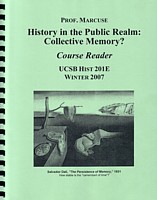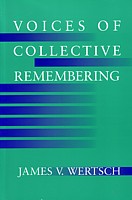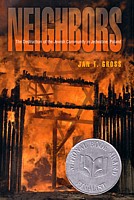| Announcements
(old announcements move to bottom)(visitor
stats)
- Oct. 22, 2017: A selection of the many articles published about the removal of US Confederate memorials after the events in New Orleans and Charlottesville:
- Rick Lyman, "Political Rage Over Statues? Old News in the Old World," New York Times (Aug. 17, 2017)
- Gracy Olmstead, "There Are Good Reasons To Consider Removing Confederate Memorials From Our Public Squares," The Federalist (Aug. 17, 2017).
- American Historical Association statement on Confederate Monuments (2017) (pdf)
- Samantha Young, "Beyond Confederacy: California Confronts Its Legacy of Slavery and Genocide," CalMatters.org (Sept. 12, 2017)
- Cheryl Jiménez Frei, "Towards Memory, Against Oblivion: A Comparative Perspective on Public Memory, Monuments, and Confronting a Painful Past in the United States and Argentina," The Public Historian special online issue (ca. Sept. 2017)
- Oct 21, 2017: On the commemorative practices and anniversaries of mass shooting events in the United States:
- Recent publications:
- Patrick Finney (ed.), Remembering the Second World War (NY: Routledge, 2017), 266 pages, 15 b/w ill. (publisher's page with TOC)
- Oct. 19, 2017:
Two mass media products with great short discussions of memory concepts:
- Michael Specter, "Partial Recall: Can Neuroscience Help Us Rewrite Our Most Traumatic Memories?," New Yorker May 19, 2014: provides an excellent summary of what we know about the neurobiology of memory and forgetting. Specter summarizes the work of Elizabeth Loftus, Eric Kandel, Daniella Schiller, and clinician
- Alison Landsberg was interviewed in depth about her theory of prosthetic memory for the NPR show On the Media on Oct. 4, 2017, as part of a discussion about the film Blade Runner and the memories implanted in its 'replicants.' "What's So Bad About Being A Replicant?" (14 mins.). It offers a great explanation and application of what
- Oct. 5, 2017: Dan Bilefsky, "Canadian Holocaust Memorial Neglects to Mention Jews," New York Times (Oct. 5, 2017).
This came after US President Trump was criticized for not mentioning Jews in his Jan. 2017 statement on Holocaust Memorial Day. This monument in Ottowa was designed by Daniel Libeskind (Berlin Jewish museum, NYC 911 memorial, among others). [Why was this such a big deal--one needs to know more--is there any documentation, or just the monument?]
- Aug. 24, 2015: Why do we--even in court--expect memory to be able to recall events exactly? Good discussion here: "Total recall: truth, memory and the trial of Oscar Pistorius," in: The Conversation, April 10, 2014.
- On the 9/11 Museum:
- Hoskins, Gregory. "The Politics of Memory and The World Trade Center Memorial Site" Journal of Social Philosophy 38(2007), 242–254.
- Billie Pivnick, "Enacting Remembrance: Turning Toward Memorializing September 11th" Journal of Religion and Health 50(2011), 499–515.
- "A Memorial Inscripion's Grim Origins," New York Times, April 2, 2014.
- Adam Gopnik, "Stones and Bones," New Yorker, June 30, 2014.
- Slavery Memorials
- Atlantic Studies (Fall 2012): Special issue
- Aug 12, 2015: 2002 article by Charles Maier, "Hot Memory … Cold Memory: On the Political Half-Life of Fascist and Communist Memory," in: Europäische Revue, published at Tr@nsit online.
- Aug. 11, 2015: new publications, some recommended on H-Memory thread on May 8, 2012, query "Theories of History and Memory" and "Memory and Generations" for an intro class:
- Astrid Erll, Memory in Culture (New York: Palgrave Macmillan, 2011).
- Tony Horowitz, Confederates in the Attic (1998). (wikipedia; $5ish on amazon) Written by a journalist, here is a particularly good chapter where he meets Shelby Foote and this could be tied in to the Ken Burns series where Foote was prominently featured. For addressing theory, I also recommend The Vichy Syndrome. Rec. by Peter Utgaard, Cuyamaca College.
- Geoffrey Cubitt, History and Memory (Manchester UP 2007) and
Astrid Erll, Memory in Culture, transl Sarah Young (Palgrave 2011). rec by Judith Pollmann, Leiden, Netherlands. (see her Early Modern Memory bibliography)
- Astrid Erll and Ansgar Nünning (eds.), Cultural Memory Studies: An International and Interdisciplinary Handbook (New York: de Gruyter 2008). rec by Britta C. Jung
- Caroline Schaumann, Memory Matters: Generational Responses to Germany's Nazi Past in Recent Women's Literature (Berlin, New York: de Gruyter, 2008). rec. by Scott Denham
- Bruce E. Baker, What Reconstruction Meant: Historical Memory in the American South (Charlottesville, Va.: University of Virginia Press, 2007). For modules concerning race, slavery and memory. Rec. by Rebecca Fraser, Univ. of East Anglia.
- Susannah Radstone and Bill Schwarz (eds), Memory: Histories, Theories, Debates (Fordham University Press 2010). ($35 at amazon)Rec. by Susannah Radstone
- Stephen Lendman's review of Ilan Pappe, The Ethnic Cleansing of Palestine" (2007) talks about memoricide.
- Chan, Gaye and A. Feeser: Historic Waikiki: A History of Remembering and Forgetting
- El-Haj, Nadia Abu, Facts on the Ground: Archaeological Practice …in Israeli Society
- Zerubavel, Yael, Recovered Roots: Collective Memory and the Making of Israeli National Tradition (Chicago: University of Chicago Press, 1995), esp. ch. 5, 11, Conclusion.
- Flores, Richard, Remembering the Alamo: Memory, Modernity, and the Master Symbol
- Handler, R. & E. Gable, The New History in an Old Museum
- Yoneyama, Lisa, Hiroshima Traces: Time, Space, and the Dialectics of Memory
- Nov. 13 , 2013: more publications
- (national) Michael Wert, Meiji Restoration Losers: Memory and Tokugawa Supporters in Modern Japan (Harvard UP, 2013): Using a wide range of sources, from essays by former Tokugawa supporters like Fukuzawa Yukichi to postwar film and "lost decade" manga, Michael Wert traces the shifting portrayals of Restoration losers. By highlighting the overlooked sites of memory such as legends about buried gold, the awarding of posthumous court rank, or fighting over a disembodied head, Wert illustrates how the process of commemoration and rehabilitation allows individuals a voice in the formation of national history. He argues that the commingling of local memory activists with nationally known politicians, academics, writers, and treasure hunters formed interconnecting memory landscapes that promoted local figures as potential heroes in modern Japan.
- (sites) Polly Low, Graham Oliver, and P.J. Rhodes (eds.), Cultures of Commemoration War Memorials, Ancient and Modern (Oxford UP, 2013)(OUP page): This volume presents studies of military commemorative practices in Western culture, from 5th-century BC Greece, through two World Wars, to the Vietnam Veterans Memorial. This new comparative approach reveals that the distant past has had a lasting influence on commemorative practice in modern times.
- June 30, 2013: some recent publications
of relevance
- (sites) Manfred Hettling and Jörg Echternkamp (eds.), Gefallenengedenken im globalen Vergleich. Nationale Tradition, politische Legitimation und Individualisierung der Erinnerung (Munich: Oldenbourg, 2013). (June 2013 Sehepunkte review by Ina Markova)
- Polly Low, Graham Oliver and P. J. Rhodes (eds.), Cultures of Commemoration
- Jan. 3, 2013: relatively new journal (since 2008): Journal of Educational Media, Memory, and Society, published by Berghahn books on behalf of the Georg Eckert Institute for International Textbook Research in Germany.
- Blurb: "JEMMS explores perceptions of society as constituted and conveyed in processes of learning and educational media. The focus is on various types of texts (such as textbooks, museums, memorials, films) and their institutional, political, social, economic, and cultural contexts. The construction of collective memory and conceptions of space, the production of meaning, image formation, forms of representation, and perceptions of the "self" and the "other", as well as processes of identity construction (ethnic, national, regional, religious, institutional, gender) are of particular interest. Special importance is given to the significance of educational media for social cohesion and conflict. The journal is international and interdisciplinary and welcomes empirically-based contributions from the humanities and the social sciences as well as theoretical and methodological studies."
- 4:2(Summer 2012) special issue: "Museums and the Educational Turn: History, Memory, Inclusivity"
- Oct 4, 2012: Some new essays & websites that I've been reading:
- Gavriel Rosenfeld, “A Looming Crash or a Soft Landing? Forecasting the Future of the Memory ‘Industry’.” The Journal of Modern History 81:1 (March 1, 2009): 122–158. pdf
- Eley, Geoff. “The Past Under Erasure? History, Memory, and the Contemporary.” Journal of Contemporary History 46:3 (July 1, 2011): 555–573. pdf
- Aleida Assmann, Jan. 2011 interview "Was bedeutet eigentlich Erinnerung?" (published on the Goethe Institute website (in German).
- Goethe Institute, "Konstruktion der Erinnerung" project with its Dossier Construction Remembrance. It is a very rich site with lots of short essays by many experts. It looks like most of them were posted/translated in 2007.
- Aug. 28, 2012: 1968 essay by Thomas Nipperdey, "Nationalidee und Nationaldenkmal in Deutschland im 19. Jahrhundert," Historische Zeitschrift (1968); from idem, Kultur, Gesellschaft, Theorie: Gesammelte Aufsätze (Göttingen, 1976), 133-173, 22 page pdf, added to National Memory section, below.
- July 12, 2011: May 2012 conference in Denmark: "Conflict in Memory: Interpersonal and Intergenerational Remembering of War, Conflict and Transition". Proposals due by Jan. 15, 2012.
- Feb. 14, 2011: Just published: Jeffrey Olick, Vered Vinitzky-Seroussi, Daniel Levy (eds.), The Collective Memory Reader (Oxford University Press, 2011)($27 at amazon, with TOC)
- Jan. 1, 2011: program of an April 2010 conference on Death/Dark/Thanatourism
- Oct. 31, 2010: add to week 5/site: Int'l Coalition of Sites of Conscience website.
- It was founded in 1999 as the International Coalition of Historic Site Museums of Conscience, to:
"assist the public in drawing connections between the history of our sites and their contemporary implications. We view stimulating dialogue on pressing social issues and promoting humanitarian and democratic values as a primary function."
- Has plenty of pdf articles, definitions, etc.
- Aug. 26, 2010: I just noticed that an important book by one of scholars I respect most, Lutz Niethammer's Kollektive Identität: Heimliche Quellen einer unheimlichen Konjunktur (Reinbek: Rowohlt, 2000), 680 pages, is hard to get even from Interlibrary Loans.
- While I think that Niethammer's complete rejection of the concept is overblown, his careful archaeology of the use of the concept in the first half of the 20th century is very enlightening.
- This review essay includes a detailed summary description:
Dietmar Rost,
"In der Geisterbahn kollektiver Identität. Lutz Niethammers Kritik einer Begriffskonjunktur,"Forum qualitative Sozialforschung 4:2(Mai 2003); full text online
- It is available cheaply at amazon.de, for about $30 at amazon.com
- July 18, 2010: Jeffrey Olick et al (eds.), The Collective Memory Reader (Oxford Univ. Press) is due to be published in Dec. 2010. (publisher's site Table of Contents) This book organizes dozens of excerpts and key texts into five categories:
- Precursors and Classics (Nietzsche, Vygotsky, Freud, Halbwachs, Bloch, ...)
- History, Memory and Identity (Confino, Yerushalmi, Assmann, Olick,...)
- Power, Politics, and Contestation (Bodnar, Hobsbawm, Schudson, Kansteiner, ...)
- Media and Modes of Transmission (Welzer, Hirsch, Zelizer, Koselleck, Young, ...)
- Memory, Justice, and the Contemporary Epoch (Hutton, Nora, Winter, Maier, ...)
- May 15, 2010: Quite a few conferences about collective/social memory
are being held, as well as some new publications. Here are some links to see
what's going on:
-
Conference on 15th century religious locations: "Vom 'Milieu de
mémoire'
zum 'Lieu de mémoire'? Methodisches zu religiösen Erinnerungsorten
im östlichen Europa anhand ausgewählter Beispiele," Uni.
Stuttgart, May 2010. HSozKult
Conference Report
-
Konferenz "Formen
und Funktionen sozialer Gedächtnisse," Dec. 10-12,
2010, Erlangen. HSozKult
Call for Papers page.
- Workshop "Spanische Erinnerungsorte,"
Institut für Europäische Geschichte, Mainz, May 25, 2010. program
on HSozKult
- Interkulturelles Erinnern? Gedenkstättenarbeit in der Migrationsgesellschaft,
Verein Gedenkdienst, Vienna, June 26, 2010. program
on HSozKult
- Book: Julia Obertreis and Anke Stephan (eds.), Erinnerungen
nach der Wende: Oral history und (post)sozialistische Gesellschaften
= Remembering after the fall of communism (Essen : Klartext, 2009),
401 S. Rezension,
von Linde Apel. - In: AfS 50 (2010)
- Apr. 30, 2010: Jeffrey
Olick's Univ. of Virginia website links to pdfs of a number
of his articles on memory, including his entry
"Collective Memory" for the International Encyclopedia of the
Social Sciences. An important anthology of key texts is due to be published
soon:
- The Collective Memory Reader (with Vered Vinitzky-Seroussi and
Daniel Levy). Oxford University Press, in press 2010.
- Sept. 26, 2009: Some new books, reviews, etc. to add in the
right places when I get a chance:
- Reenacting, new popular book: Tim Moore, I Believe in Yesterday:
My Adventures in Living History (Vintage, 2009)($13
amazon page)
- Dealing with the Past in Asia: special edition of Zeithistorische
Forschungen,
June 2009. Excellent series of articles on numerous countries (in German):
Palastmuseen in China & Taiwan (31p.
pdf); Yakusuni Shrine in Japan (23p.
pdf); ...
- Sites: Berlin
- Aug. 24, 2009: Natan Sznaider. Gedächtnisraum Europa: Die
Visionen des europäischen Kosmopolitismus; eine jüdische Perspektive.
Bielefeld: transcript Verlag, 2008. 153 pp.
- Aug 2009
H-German review by Daniel Levy: "Methodologically,
Sznaider makes an invaluable contribution to the burgeoning field of studies
in which the nexus of memory and history takes center stage. In contrast
to most case studies, which still focus on the tensions between memory
and history, Sznaider's analysis suggests a more complex dynamic that draws
on their interaction. He is not primarily interested in historical events
but rather with their mnemohistory: that is, following Jan Assman, how
pasts are remembered over time and how the conditions for their appropriation
change.[1] What matters here is not so much the facticity of an event,
but how the past is inscribed into different memory cultures. How histories
are remembered (and by extension distorted) over time emerges as the main
focus of analysis: not the factuality of memories but their actuality.
In contrast to Assmann's emphasis on what is remembered, however, Sznaider
insists on considering who is remembering. He makes a strong case for recognizing
that each group has its distinctive way of immobilizing time, as memory
practices are mediated by the idiosyncratic features of a group's experiences
in time and distinctive cultural dispositions towards specific pasts and
pastness in general. Thus, scholars need to attend to the kind of cultural
validations specific groups attribute to temporal phenomenon such as progress,
change, innovation, and memory itself (and of course, to the fact that
groups have different experiences). The distinction between what is remembered
and who remembers is especially important given that the consolidation
of a universalizing Holocaust memory culture in European discourse and
public rituals is essentially based on the obliteration of particular (Jewish)
memories. Sznaider's book is a remedy against the oblivion that has accompanied
the European memory boom and its concomitant politics of apology.
[1]. Jan Assmann, Moses the Egyptian: The Memory of Egypt in Western
Monotheism (Cambridge: Harvard University Press, 1997), 9-10: "Mnemohistory
is not concerned with the past as such, but only with the past as it is
remembered.... It concentrates exclusively on those aspects of significance
and relevance which are the product of memory--that is, of a recourse to
the past- and which appear only in the light of later readings.... The
present is 'haunted' by the past, and the past is modeled, invented, reinvented,
and reconstructed by the present.... Mnemohistory analyzes the importance
which a present ascribes to the past."
- Sept. 5-9, 2009
conference by
Collegium Carolinum, Munich; Projekt "Musealisierung der Erinnerung
– Zweiter Weltkrieg und nationalsozialistische Besatzung in Museen,
Gedenkstätten und Denkmälern im östlichen Europa" (program
on H-Soz-Kult)
- Feb. 26-27, 2009: The Second Annual Conference of
the NSSR Interdisciplinary
Memory Group. Some of the issues that the conference will address include:
- The internationalization of memory: How are models
and meanings transported around the world
- Denial, imposture and historical events—Can
a scientific method limit dubious mobilization of memory
- Memory and revenge
- Narrative and visual memory: What do they want memory
“to do for them” (Eyal, 2004) or how the form serves the aim
- Memory (Studies) and the Future
- Jan. 22, 2009: new book: Astrid Erll and Ansgar Nünning
(eds.), Cultural Memory Studies: An International and Interdisciplinary
Handbook (= Media and Cultural Memory/Medien und kulturelle Erinnerung
8) (Berlin: de Gruyter 2008), 441 S., EUR 98,00. (1/22/09
HSK review by Malte Theissen, FZ Hamburg)
- Jan. 5, 2009: This page and seminar is now one layer
deeper to make room for my current 201e seminar on Museums and History.
- Nov. 26, 2008: A former student sent me this article
from a new journal Memory Studies: Paul Connerton, "Seven
Types of Forgetting," in: Memory Studies 1:1(2008),
60-72. (pdf; abstract
with link to free pdf in upper right). His types of forgetting: Repressive
Erasure, Prescriptive Forgetting, Forgetting Constitutive of a New Identity,
Structural Amnesia, Forgetting as Annulment, Forgetting as Planned Obsolescence,
and Forgetting as Humiliated Silence. (thanks to Paul Sandul for the reference)
- Oct. 19, 2008: See this review
(in German) of the 2007 Festschrift for Aleida Assmann: Arbeit
am Gedächtnis (20 essays). Part IV is about Generation and Memory.
- Also Jason
Tebbe's H-Memory review of Jeffrey Olick's book: The Politics of
Regret: On Collective Memory and Historical Responsibility (New York
Routledge, 2007), 229 pp. It
sounds like a critique of Halbwachs' static concept of Collective Memory
that lays out a process-oriented alternative ("counter-concepts"
laid out on p. 91). The periodization of postwar German 'memory' by the
interpretations of May 8, 1945 strikes me as an odd one to choose, but
I haven't read the book yet.
- Sept. 26, 2008: This Oct. 2008 conference in Kiel,
"Geschichtspolitik und kollektives Gedächtnis. Rückblick,
Kritik, Perspektiven," announcement
on HSK has a number of interesting presentations. It would be worthwhile
to see what the presenters have published.
- Aug. 1, 2007: I just discovered an interesting radio
show (WNYC's Radiolab, June 8, 2007) on the physiology of memory: "Memory
and Forgetting." The first 22 mins. before the break are the most
relevant in a social-historical context.
- Apr. 1, 2007: good links on History and the
Internet:
|
 Salvator
Dali, "The Persistance of Memory," 1931
Salvator
Dali, "The Persistance of Memory," 1931


